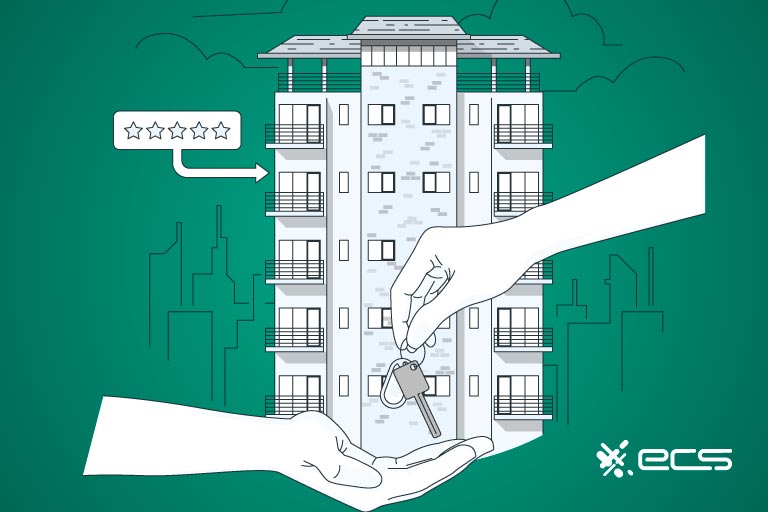Remember playing Monopoly as a kid? For some real estate investors, it was Uncle Pennybags who lit the fires of inspiration. Wouldn’t it be great if collecting rent from your tenants was as easy as collecting $200 every time you passed Go? Or every time someone landed on a property named after Atlantic City streets? As it turns out, collecting rent really can be that easy…if you use a payment processor for online rent payments.
What Are the Biggest Problems Faced by Landlords?
According to a survey by Zillow, 71% of landlords said screening tenants was burdensome. Other activities found burdensome were scheduling tours with potential tenants (51%), repairs and maintenance (92%), renovations (51%), and collecting rent payments (36%). As a side note, the median landlord among the 1,000 surveyed property owners had two properties in their portfolio.
There are some interesting implications to this survey. Aside from collecting rent, property ownership (for many investors) is not entirely the passive income stream it’s touted to be. There is always something to fix at some odd hour.
But another upshot is the significant percentage of property owners who have trouble collecting rent. Imagine any other type of B2C business having trouble collecting payment from 36% of their customers…they’d go out of business. We specify B2C because commercial real estate is a different game (more on that later).

Are Landlords Lagging Behind Other Industries in Terms of Tech?
It’s also interesting to note that the median landlord of surveyed investors owned two properties. Investors with a smaller portfolio may use Lofi methods to manage their business. They may be running some of the operational considerations on their own, such as maintenance, accounting, and collecting rent.
To be straightforward, landlords lag behind other industries in adapting operational business tech. A whopping 42% of rent is collected in the form of a paper check. 22% is paid in cash. 16% is paid with a money order, and 20% is paid by other means, such as credit card, debit card, or ACH.
This survey was conducted by the Federal Reserve and had some other interesting findings. Around 58% of renters are aged 25-44, while 71% of landlords are 45 and older. These age demographics are particularly remarkable in light of how consumers feel about paper checks in general.
A different Federal Reserve study found that consumers aged 25-44 use checks for just 3% of their transactions. And the group using them most often (65 and older) used them just 9% of the time.
So given the fact that consumers don’t like checks, why are they using them for rent?
How Do Renters Feel About Using Cash?
Before we explore some possible answers to that question, let’s look at how consumers feel about cash. After all, 22% of renters are still paying their rent in cash.
Yet another Federal Reserve study found that consumers aged 25-34 use cash 12%, and 13% of the time for consumers aged 35-44. Consumers 45-54 use cash 16% of the time, and those 55 and up use cash around 23% of the time. While these numbers are somewhat more reconcilable than those in the area of paper checks, there is still somewhat of a mystery.
But cash usage does also relate to income. Cash usage increases as income decreases. Households making more than $150,000 annually use cash just 10% of the time.
- Households making $75,000 to $149,000 use it 15% of the time.
- Those earning $50,000 to $74,999 use it 19%.
- Those making $25,000 to $49,999 use it 23%.
- Those making less than $25,000 use it as much as 36% of the time.
These numbers are making cash payments slightly more understandable. Renters have a median income of $40,500, while homeowners have a median income of $72,615. Although there are exceptions to every rule, renters tend to be in lower income brackets than their landlords. This, in turn, makes them more likely to make cash payments.
Some overlap may be found in the fact that 4.5% of households in the United States do not have a savings or checking account. Any unbanked renters cannot use checks. They must rely on cash or money orders to pay their rent.
There could be any number of reasons why such renters are unbanked and paying for things in cash. While we cannot tangent into conjectures, it may be that such renters are primarily being paid in cash.

Renter Sentiment May Be Driving Check Usage
As for checks, consumers—while often showing a preference for card payments over checks or cash—do still use checks for some purchases…especially large ones. The average check value was $365, indicating that while checks are not a popular overall method of payment, they are used for larger transactions such as recurring service bills, rent, and services.
In fact, of all checks written, 10.1% of the total dollar value is issued for rent payments, making rent the second largest category (the first is financial services at 30%). Checks are followed by school tuition and childcare (8.2%), taxes (7.7%), building contractors (6.5%), and general merchandise (6.1%).
The context of these numbers showcases that checks are used for large, recurring payments that are staple considerations in life or part of long-term goals. These might include property, taxes, and education, as a few examples.
There is a sense of permanence about writing a check and handing it over. There is a weight to the formality which feels solid and reassuring. Consumers equate debit and credit card purchases with things that are here today and gone tomorrow—like food, entertainment, and consumer staples like toilet paper (not necessarily in that order). By contrast, the ritual of a check feels permanent…the kind of feeling you want when dealing with real estate, whether renting it or collecting rent.
The Problems with Check Payments
Checks are also burdensome to collect, as is cash. If the check is getting mailed, you’ll have to wait for it to come in the mail. It could get lost. When it comes, you have to cash it. There may be fees. If it’s not getting mailed, the renter has to come into your office and deliver the check.
The Problems with Cash Payments
Cash is not better. In fact, in many ways, cash is worse. Cash cannot be mailed (it’s dangerous and illegal). If the cash is successfully handed over, you have to keep it safe. It can get lost, stolen, or counterfeit. Then there is also the fact that if renters are paying in cash, they are doing something illegal, which will cause problems.
Neither checks nor cash are not automatic; payment with these methods has to be initiated by the renter. The renter could forget in good faith. Some landlords let it go until the 15th of the month. Others try to politely remind their renters. This can create negative interactions. And there are limits to how much you can remind your renter in some states.
There may be times when the renter willingly “forgets.” They may be behind on their other bills and decide to skip rent. As it’s pretty difficult to evict someone in most states, they may feel comfortable being late with you and making sure they pay their other bills on time. You really don’t know what they’re thinking…but you do know that you’re not getting paid.
The Problems with Money Orders
Money orders are also problematic. Your bank may charge a fee for cashing money orders. Money orders can also get lost, and they are not like regular checks. A regular check represents a transaction value. If it’s lost, the transaction can be renewed.
A money order is the transaction itself…sort of like paper money. You cannot replace it. There is also the concern that if your tenant is using money orders, they are doing something illegal (they don’t want a bank account for whatever reason).
Cash, check, and money orders present significant problems in collecting rental income. And yet, for some reason, they strongly persist, especially in the economy of investors with a handful of properties (as opposed to larger institutional investors). Perhaps these landlords are too busy to consider that there is a very easy way to set up recurring payments.

Property Management Payment Processing
The solution to the problem of collecting rental property payments from tenants is to automate the process. Automated rental payments take excuses away from tenants and ensure payments arrive on time. And the way to automate payments is not to send someone out to your properties with a baseball bat. It’s online rent collection software.
Rental payment gateways allow tenants to log on and input payment information. The rent payment platform will save their payment information securely for future use. They can log on to the online rental payment portal if they want to change their payment information (such as using a different card or checking account).
When the lease or rental agreement is signed, asking your tenants to pay rent online can be laid out as an expectation. The online rent payment portal can also be how you collect a security deposit and the first and last months of rent (or whatever you collect).
Now on to the question you might ask: how do you get this kind of hosted payment page? That’s where a payment processor comes into play.
What is a Payment Processor?
A payment processor or merchant services provider is two separate things. Payment processors help process payments at a point of sale (or online). Merchant services is a more general term encompassing other services, such as transferring payments into your business bank account. Suffice it to say a payment processing company or merchant services provider will be the party that sets up and manages your hosted payment page for the rental collection.
In broad strokes, here is how payment processing works. A tenant puts their credit card information into the payment portal. The payment processor then sends this information to the card networks (Visa, Mastercard, Amex, Discover).
The card networks check in with the tenant’s bank. Do they have enough cash or credit to cover the payment? If they do, that information is passed back to the landlord’s bank through the card network. A transfer of funds is initiated, which usually takes 24-48 hours.
Credit Cards Versus ACH Transfers
There will mainly be two ways in which a rental payment online occurs. One is inputting credit or debit card information (card number, expiration date, and security code). We have suggested that card payments have a significant benefit over cash or check in that they can be automated. They are secure and cannot get lost (unlike cash or checks). But are there any downsides to card payments?
Indeed, there are, and those are the fees. Landlords will pay a merchant discount rate for the privilege of accepting credit and debit card payments. This merchant discount rate includes interchange fees and assessment fees charged by the banks and card networks for facilitating payments. Generally speaking, these will hover around 2% to 3% of the total payment.
You are legally allowed in most states to add a surcharge to card payments. This surcharge can pass the operating expense of accepting card payments on to the tenant. However, it can also provide a negative tenant experience. That’s why you want to give your tenant one more option for paying rent online: ACH.

What Are ACH Payments?
ACH stands for the Automated Clearinghouse Network. A clearinghouse is a sort of bank that facilitates the transfer of money from one party to another. In this case, it’s a transfer of money from the tenant’s bank to your bank.
ACH payments are essentially bank transfers, but they are not wire transfers. Wire transfers are instantaneous, expensive, and irreversible—which is why they are the favorite method of long-lost African uncles who want to ensure they can send you money.
Operators send ACH payments in several batches throughout the business day. Card networks are not involved in the transfer of these funds. In some cases, certain banks already have reciprocal relationships set up, which makes the transfer even more direct (and faster).
And the best part of ACH payments for landlords is that the fees are just a few dimes per transfer. That’s right…card payments can cost (as mentioned) as much as 3%.
Suppose you are collecting card payments for rent. That comes to around $45 for every $1,500. If you don’t pass those costs on to the tenant, that’s $540 per year. That might be the cost of a kitchen appliance (if you know where to shop).
You can pass those fees on to the customer, but more likely than not, they’ll be upset about it…or at least mildly perturbed. A win-win solution is to use ACH payments. The money takes about the same amount of time to move, costs less, and is secure.
Other Benefits To Online Rent Payments: Integration
Another benefit to online rental payments is that they are software-based. And one of the great things about software is that it can integrate with other types of software. The rent collection platform can be integrated with accounting software, eliminating the manual task of translating cash flow into the books.
Online rental payments can also be integrated with other features that make managing your rentals easier. The payment portal can also be a place for the customer to report maintenance problems. This management feature can reduce phone calls by funneling complaints into work orders for your property manager or maintenance staff.
Payments can also be synchronized with portfolio management benchmarks for non-acute maintenance issues. For instance, 12 months of payment could trigger a cue to steam clean or change carpets. Three months of payment could trigger a reminder to have a maintenance person swap out air filters and check smoke detectors.

Online Rent Payments for Commercial Spaces
Commercial real estate is a much different ballgame than residential. The base rents are much higher. Tenant screening is more extensive than credit scores and criminal records—they also involve a review of the underlying business. But the extra legwork is worth it, as commercial renters create the most lucrative leases.
Commercial lease payments are very different from residential leases. They are more complicated and involve more components.
With a full-service or gross lease, the tenant pays a base rent, while the landlord handles building expenses, maintenance costs, insurance, and property taxes. It’s commonly used in properties with multiple tenants, like an office building. Who pays for the utilities varies from situation to situation (and is probably the subject of much negotiation).
Net leases pass on some of the building expenses to tenants. These can include common area expenses (CAM), utilities, insurance, and property taxes. The pro-rata share of these extra expenses is typically calculated along the building percentage occupied by each tenant.
Triple net leases, or NNN leases, involve the tenants shouldering all the building costs (maintenance, utilities, insurance, and taxes). Double net or NN leases involve tenants paying for utilities, insurance, and taxes, not maintenance. And single net or N leases involve the tenant paying for utilities and property taxes, with the landlords paying for insurance and maintenance.
Online Payments For Commercial Leases
What type of lease a landlord uses will depend on several factors. But there are even more lease types than the ones mentioned here. Lease types with variables (such as utilities and insurance) are most certainly commercial lease payments that should be automated.
That’s because the periodic rent is changing. Calculating the pro-rata amount shared by each tenant can be immensely time-consuming based on the percentage of area occupied and other factors. A commercial lease-hosted payment page is automated by software that can automate many of these calculations and present each tenant with a final amount.
Breakdown of Expenses
Online payments for commercial leases can show each tenant a breakdown of the expenses, especially for NNN, NN, and even N tenants. They will appreciate a dashboard with a pie chart showing the breakdown of their rental costs. This type of transparency can improve the relationship between the landlord (you) and your renters. They may ask to see a breakdown of the expenses, and having a payment portal dashboard that presents this information will automatically eliminate a lot of back and forth.
Collecting rent from commercial tenants is easier than from residential tenants. Or is it? One would expect B2B transactions to be more punctual. But commercial enterprises also go through hard times. Some of them even file for bankruptcy.
Recent events show commercial real estate investors the potential fragility of the industry, with over 700,000 businesses closing their doors for good during or after the Covid Pandemic.
Before this happens, commercial tenants might attempt to settle their other bills with vendors and suppliers. Having a hold on their bank account with an ACH payment can help make sure you collect your rent without having to track them down. By contrast, waiting for them to show up with a paper check may result in you waiting a long time.
Online Rent Payments Wrap Up
Residential and commercial lease-hosted payment pages make it easy for landlords to automate online rent payments. The automated collection immediately eliminates inconsistency. It also eliminates other pitfalls of collecting paper payments like cash and check (such as losing the check or investing time and money in deposits).
Payment processors provide payment gateways that facilitate online rent payment. The payment processor can store all tenant payment information (card or bank account info) while meeting data security standards. This will allow you to automate the rent collection process without compromising the security of your tenants and their personal information.
Automated, online rent payment can also be integrated with other time-saving software solutions such as accounting, reporting, and property management. To learn more about how much online rent payments can improve the ease of managing your portfolio, contact us.
